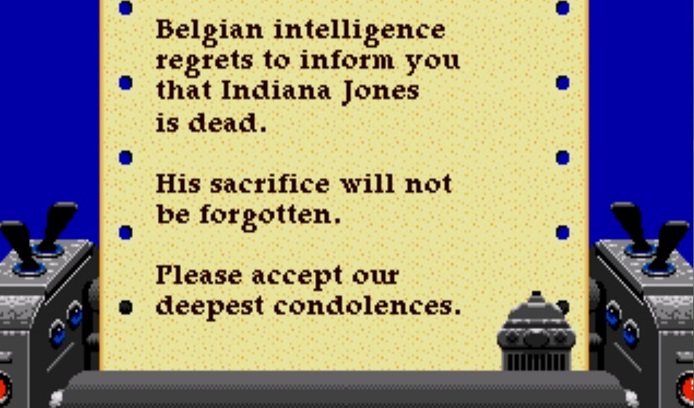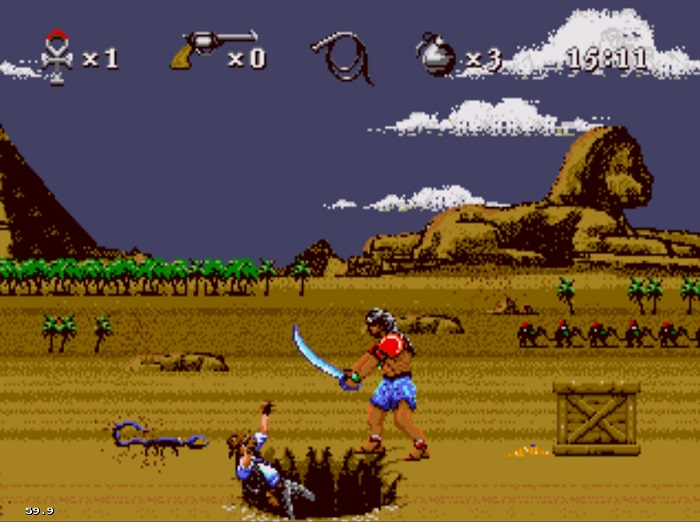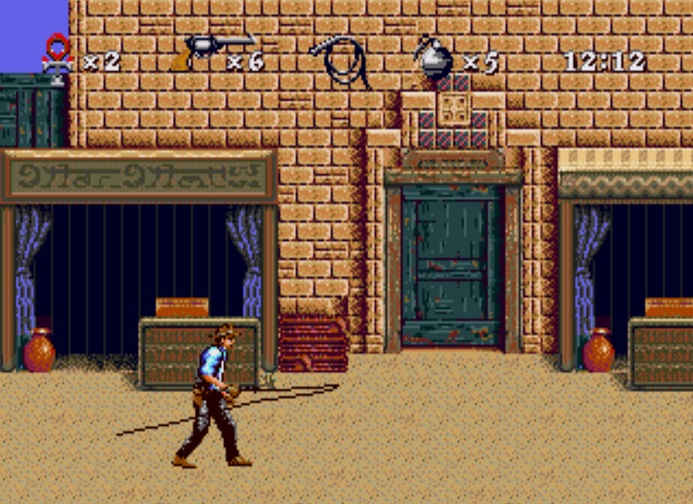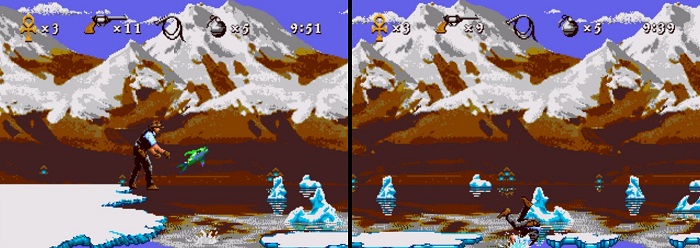The Young Indiana Jones Games
The Young Indiana Jones Chronicles
NES - Jaleco, 1993
Most of The Young Indiana Jones Chronicles mirrors the tv show of the same name, and if you’re familiar with the show then you will recognise almost all of it in some form. You might also assume it follows some of the more light hearted episodes such as his comedic spy adventures, but these would have to wait until Instruments of Chaos (see below, there is nothing amusing about it, sadly). Instead, it begins as Indy joins the Mexican revolution and follows his travels to Europe to take part in the Great War. Yes, the genuinely harrowing and extremely poignant parts of various war episodes are the focus, even to the point of getting gas masks to avoid deadly hazards in the trenches of France.

The tone of the game is a normal 90s action game with cheery chiptunes so while it’s an odd choice of time period (although I suppose it is the setting with the most action) it won’t leave children mentally scarred for life like the tv show did for many of us. Instead you will explode things and battle enemies such as Pancho Villa and Baron von Richthoven. As far as 1993 action platformers go, it’s not actually bad at all. It’s fast-paced and feels much more responsive than The Last Crusade: The Action Game.
It’s not surprising that it does a good job adapting the tv show, as the developer, Chris Grey Enterprises were already very experienced handling movie and tv show properties. By 1993 they had handled Captain Planet, Dirty Harry and Mad Max, and would go on to develop games for Terminator, James Bond and Wayne’s World, among others. Some of these were well received, and Young Indy was not a bad early effort for the studio.
The platforming and combat feel fair. It’s quite varied as well, with multiple types of melee and projectile weapons to play with, all slightly different. There are a decent number of enemy types which require different approaches and even some environmental hazards like quicksand and mud, and boulders. This time it’s not our hero getting chased, but you can roll them down slopes to knock out enemies. And it’s not just the combat, but variety in the rest of the game too. There are periodic houses to go into, akin to going down a bonus pipe in Mario Bros. In some levels you need to find a light in order to see better, and there is even a variety of vehicles to ride. A good amount of effort went into it rather than it being another cookie-cutter platformer.

Save states are a must here though, if you value your time. It’s hard, as many 90s platformers were, and you don’t earn enough extra lives (by collecting gold ingots inexplicably strewn throughout rural France and Mexico) to keep going without learning every bit of the levels.
It’s not the best NES game ever, and not the best NES platformer either, even discounting the Mario games. But the variety and the alignment with its silver-screen cousin kept me interested. As a tv tie-in game a surprising amount of effort was put into it, and it’s a good example of a standard fare 90s console platformer, unlike the other Young Indy game.
Instruments of Chaos Starring Young Indiana Jones
Sega Genesis/Mega Drive - Sega, 1994
Instruments of Chaos was made by Brian A. Rice Inc., which until 1994 seems mostly to have made casino games and other curios. The only other game in a similar genre from the developer was the Sega Genesis version of Home Alone, an oddly constructed side-scrolling game that people either seem to love or hate. They also created a dungeon crawler based on the Willow movie with which Lucasfilm was involved, which is perhaps where the Indiana Jones connection comes from. During this period Lucasfilm were still farming out console releases to many other companies while they focused on PC games, Fate of Atlantis coming out two years previous. Lucasarts only ported a few games to any Sega platforms, and Instruments of Chaos has the honour of the only title they released exclusively on a Sega console.

Instruments of Chaos is another poor effort in the string of poor Indy console action platformers, and it's incredible that it came out in the same year as the SNES game Indiana Jones’ Greatest Adventures, which is infinitely better.
Jumping is terrible, jumping diagonally makes you go higher, so it’s the only way to do any platforming, even though in some levels you have to climb vertically. If you land on a human enemy who is walking, you can ‘ride’ him to the end of the level, endlessly bouncing off him. In fact even walking is slow, the character sometimes breaking out into a run at inopportune times.
Combat is equally terrible, although admittedly it took me a while to figure out just how to kill any enemies at all except the humans that you simply shoot once if you have any bullets left. Each level has creepy crawlies such as snakes, small enemies like monkeys, none of which you can hit, as you can’t attack while crouched. There are of course annoying flying enemies which you can also not hit, even if you jump and attack or whip upwards.

To hit anything, including crates, you must stand still, hold the whip button, and then spin the D-pad in circles continuously, hoping you hit them multiple times. The whip is a good idea, it’s also used for climbing sections, and the dynamic movement of the whip looks fantastic for the technology of the time. But stopping to twirl it for a while interrupts the flow of the game, and it looks ridiculous.

Another positive is being able to choose the order in which you choose the missions, aside from the final Germany mission. In practice most of them are the same. Some have verticality, the India marketplace being very similar to the first level of Capcom's Disney’s Aladdin. Released one year earlier on the SNES, it also had a marketplace level in which you could platform to the roofs, bounce on awnings, and swing on poles, but it did all of them with more fun and panache. So, in fact, did the aforementioned Indiana Jones’ Greatest Adventures on the SNES in the same year, a much slicker marketplace level with the same jumping, bouncing and swinging as Instruments of Chaos (but still not as good as Aladdin's
If you want a break from the drudgery you can choose the Tibet level and jump across icebergs while fish randomly jump at you, knocking you into the water for an instakill at any moment. The solution of course is to stand on each platform flailing your whip in a circle until you’ve killed any flying fish that might be lurking.

This is one of the games I spent the least time on, not making much progress and being sad if I did, meaning I’d have to spend more of my life spinning the whip at hordes of annoyingly designed enemies. It’s a shame as some good ideas were there and some of the later levels look colourful. Still, if I got too angry with the later levels I could just cool myself down by standing still and twirling the whip to fan myself.
